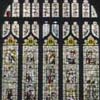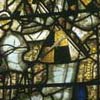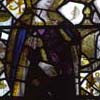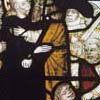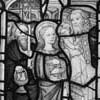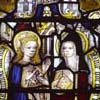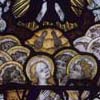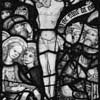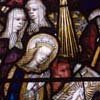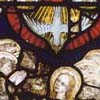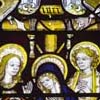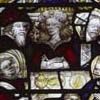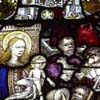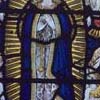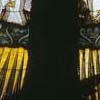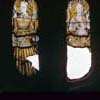Corpus Vitrearum Medii Aevi
Medieval Stained Glass in Great Britain
Your trail:
- CVMA Publications
- Norfolk: East Harling, Parish Church of Sts Peter and Paul
Norfolk: East Harling, Parish Church of Sts Peter and Paul
O.S. TL 990867
Chancel
I.
1a.
Sir Robert Wingfield, kneeling in prayer on
a blue cushion facing to sinister, wearing a surcoat over pale-blue
and yellow-stain plate armour. On the surcoat and paudrons are the
arms
Quarterly 1 & 4, Argent on a bend
gules cotoised sable three pairs of wings conjoined in lure of
the field with a crescent for difference (Wingfield); 2
& 3, Quarterly sable and or
(Bovile)
. Round his neck is the Yorkist
collar of white roses and sunbursts, with the lion of March hanging
from it; behind him is his helm. He kneels before an altar-tomb
covered with a white cloth with seaweed pattern and yellow-stain
background, on which is placed on the right a rosary. Over his head,
against a quarry background decorated with baskets and aprons, is a
blackletter inscription on a scroll: 'Fili
redemptor mu(n)d[i deus] miserere
nobis', and below the base of the chequered
pedestal in blackletter script relieved from a matt wash and
coloured with yellow stain (except for the capitals) is part of a
longer inscription: 'Orate
[pr]o Bono [… Rob]erti
Wyngefeld'. The panel has a double rod-and-leaf border
to left and right and a modern beaded fillet along the bottom.
Accomplished piece with vigorous trace-lines, careful thin matt
washes and stippling, and abraded ruby for the wings. c.1467 –
c.1480, except for the outer border, which is of nineteenth-century
date. Apart from an insertion in the upper inscription, the
incomplete nature of the lower inscription and some repair leads,
the panel is in excellent condition.
h 0.81m, w 0.60m
David King (2005, digital colour photograph)
2a.
St Mary Magdalen and fragments. Composite
panel, made up of parts of several windows. The main element is a
fragmentary figure of St Mary Magdalen. She stands facing to
sinister, holding a pot of ointment in her left hand and a tress of
her long hair in the right. She is nimbed, and other long tresses of
her hair fall to left and right. She wears a purple gown and a blue
mantle with yellow-stain edging decorated with a seaweed pattern,
white lining, and ermine trimming at the bottom. Much of her gown is
made of purple fragments from elsewhere, and the head is disfigured
by repair leads. Her feet are missing, and at the base are fragments
of various pedestals; one has an ears-of-barley pattern, and a
second a counterchanged lozenge and circle design. The background to
the figure comes mainly from another otherwise lost panel from nIII,
depicting Anne Harling. It consists of part of an invocation in
blackletter on a scrolls to the Holy Spirit: 'Sp(iri)te s[ancte deus
mis]erere [nobis]
', and
patterned quarries decorated with baskets and aprons. Also intruded
into the background are some patterned quarries with flowers, wings,
and true lovers’ knots, the last two motifs making up the rebus of
the Lovell family. c.1460–80 and c.1520–30.
h 0.68m, w 0.60m
David King (2005, digital colour photograph)
3a.
Fragments of a Te Deum
window, with parts of standing figures of angels
wearing diadems surmounted by a cross. One has an ermine tippet and
feathered sleeves; most are dressed in white gowns and tunic and
raise their hands in adoration. One holds a vial. Fragments of at
least two female nimbed and crowned saints are seen, one holding a
cross-staff, who is probably St Margaret. A fragment of a female
saint with girdle and sword may be from St Catherine. At the top is
part of a circle of cloud. Blackletter texts on scrolls from the
middle section of the Te Deum (lines 23–32) include 'Tu pa[tris sempiternus se
filius]
', 'Tu de
[victo mortis aculeo]
',
'Tu ad dextera(m) [dei
sedes]
', '
[Iudex c]reder(e)
e(ss)e venturu[s]
'.
Another fragment may be from line 4: '
[o]m(ni)s te[rra
venerator]
'. White glass with yellow stain
is used for most of the fragments, but some purple feathers and a
piece of blue glass are seen. c.1491–98. Much of the glass is badly
affected by heavy external pitting, although the paint is mainly
intact on the inside surface.
h 0.72m, w 0.60m
David King (2005, digital colour photograph)
4a.
The Annunciation. In a canopied niche with
chequered floor the crowned and nimbed long-haired Virgin kneels on
the left with arms crossed over her breast before a prie-dieu, on
which is an open book and in front of which is a pot of lilies. She
wears a blue mantle with yellow-stain edge over a white robe
fastened with yellow-stain girdle. A nimbed dove flies to her left
ear. Gabriel in a white robe, purple tunicle and diadem, kneels on
the right with left hand holding a sceptre and right raised in
greeting. Rays of yellow light shine from a ruby cloud over
Gabriel’s head. Blackletter inscriptions on scrolls, over the Virgin
'Ecce a(n)cilla
d(omi)ni', partly obscured by a
saddle-bar, and above Gabriel 'Ave gracia
/ plena'. At the top is a blackletter titulus with
'S/[a]/lutac(i)o /
be(ate) Mari(e)
'. Yellow
stain is plentifully used for details of the setting and figures.
c.1461–67.
h 0.75m, w 0.60m
David King (2005, digital colour photograph)
1b.
The Resurrection. In a canopied niche as in
4a Our Lord rises in a glory from a diagonally placed tomb holding a
cross-staff in his left hand and a blessing with his right. He is
nimbed, wears the crown of thorns, displays his wounds (the right
leg is missing), and wears a ruby and purple robe and mantle.
Soldiers in plate armour with a fur-edged jerkin, ruby on the left
and blue on the right, sit either side of the tomb, and another
stands on the left opposite a fourth soldier on the right in a
similar ruby jerkin. Three hold pole-axes and one a sword. There is
a blue-seaweed sky and white stony ground. Yellow stain decorates
armour, niches, and fur. c.1461–67. There are a few intrusions of
old glass and repair leads and Christ’s garments are corroded, but
the panel is otherwise in good condition.
h 0.74m, w 0.60m
David King (2005, digital colour photograph)
2b.
The Betrayal of Jesus. Beneath a canopied
niche that has lost its side-shafting Judas stands centrally dressed
in a brown mantle and white robe, facing Jesus (in a purple mantle)
on the left and kissing him. They are surrounded by soldiers in
plate armour carrying pole-axes, a spear, a lantern, a fire-brand,
and a brazier on a pole. One has a ruby hat. St Peter stands on the
right wearing a ruby mantle and white robe raising his sword with
his right hand and grasping the shoulder of Malchus, who looks up at
him while kneeling in the right foreground, wearing a blue tunic
with belt, purse, and dagger, and holding a lantern with his right
hand. Both he and Judas have a flesh-coloured dark faces. Bottom
left is a clifflet with blue flowers. Background and floor as 1b.
c.1461–67. Apart from an intrusion in Judas’s face and one or two
repair leads, the panel is in good condition.
h 0.72m, w 0.60m
David King (2005, digital colour photograph)
3b.
The Presentation of Our Lord. In a canopied
niche with chequered floor as in 4a the Virgin Mary stands centrally
with arms placed across her breast, nimbed, and wearing a blue,
ermine-lined mantle with decorated edging over a white robe. On the
right behind an altar stands Simeon in a red mantle decorated with
yellow roses. He holds the cross-nimbed Christ Child, who is dressed
in white. On the left stands Joseph in a ruby mantle and white robe
decorated with yellow leaves, holding a pair of doves in a basket in
his right hand and a lighted candle in his left. Behind are two
further male figures, one with a candle and ruby hat. Yellow stain
is used to enliven setting, figures, and objects; the roses are
relieved from the ruby glass and coloured with yellow stain.
c.1461–67. Apart from a few minor intrusions, the panel is in good
condition.
h 0.72m, w 0.60m
David King (2005, digital colour photograph)
4b.
The Visitation. In a canopied niche with
chequered floor as in 4a the Virgin Mary stands on the left with
hands raised. She is long-haired, nimbed and crowned, and wears a
blue, ermine-lined robe with beaded hem over a white robe with
relieved pattern. St Elizabeth stands on the right with left hand
raised and the right placed on Mary’s belly. She is nimbed, wears a
ruby mantle over a white maternity robe laced at the front, and has
a pleated barbe and veil headdress under a black fur-edged hood.
Behind the figures is a house with a door and windows. The blue sky
has the usual seaweed diaper. On a blackletter scroll to the left of
St Mary is 'magnificat
a(n)i(m)a mea', and
on one to the right of Elizabeth is 'Unde
hoc m(ih)/i ut venia(t)
'.
Both texts are slightly obscured by a saddle bar. Part of a
blackletter titulus top right reads: 'cu(m) Eliz/abeth'.
c.1461–67.
72
There are some patched areas on Mary’s robe and the pedestal, some
paint loss on the micro-architecture, and some repair leads.
Otherwise the panel is in good condition.
h 0.73m, w. 0.60m
David King (2005, digital colour photograph)
1c.
The Ascension. In a canopied niche as in 4a
the nimbed and long-haired Virgin Mary kneels raising her hands in
prayer in the centre with the twelve Apostles to each side. She is
dressed as in 4b, but without a crown. The four Apostles at the
front wear purple, yellow, white, and blue mantles, the white one
having a yellow-stain foliage pattern. Bottom right and left are
clifflets with flowers. Above Mary’s head is a hill with Jesus’s
footprints between two ruby hills and above that Jesus ascends into
a blue cloud. His feet and the lower part of his robe surrounded by
a glory are seen. On each side an angel emerging from a cloud raises
his hands in adoration. Part of two separate tituli have been
combined on a blackletter text at the top: 'Ascensio[?] / ih(esu)s
a…'. There are two glazier’s sorting marks, type 18, on
the canopy vaulting. c.1461–67. The panel is in good condition;
there are a few minor intrusions of old glass in the
micro-architecture and some repair leads.
h 0.74m, w 0.60m
David King (2005, digital colour photograph)
2c.
The Crucifixion. The scene is set under a
canopy on stony ground, but the side-shafting is missing. Christ
hangs on the cross in the centre wearing a loin cloth. The upper
part of his torso is modern. Above his head is fastened a sign with
‘in/ri’ in blackletter. To the left, St John, in ruby mantle and
white robe, supports the Virgin Mary, dressed as in 1c; a third
nimbus is seen behind. At the back on the left, Longinus, in a ruby
hat, points to his blind eye, and a man in a blue hat holds up a
bucket containing liquid, presumably wine and myrrh. To the right
the centurion sits on horseback in plate armour and a plumed yellow
hat, holding up a scroll with a blackletter inscription 'Vere filiu(s) dei
era(t)
'. Next to him a soldier in plate
armour rides a chestnut horse. Ruby background. c.1461–67. Apart
from the losses already mentioned, the centurion’s horse is patched
and the canopy is incomplete. There are a few repair leads, but the
surviving glass is in good condition.
h 0.72m, w 0.60m
David King (2005, digital colour photograph)
3c.
The twelve-year-old Jesus in the Temple sits
nimbed and wearing a purple gown on a high, throne-like seat
gesturing with his hands as he speaks to the doctors. Above on a
titulus is 'Docebat
ih(esu)s'. Behind the throne is a blue
seaweed pattern and part of a vault is seen top left. Three of the
doctors are seated on the left; the front two discuss with each
other, one pointing at Jesus; they both wear extravagant hats. Four
more sit on the right wearing purple, blue, and pot-yellow mantles.
Two are in animated discussion, and the one at the front points to
Jesus. At the front stands another doctor, wearing a pileus and long ruby mantle and tippet with
belt and purse. He faces the doctors on the right and clasps his
belt behind his back. Behind him the Virgin Mary enters with hands
raised in dismay. She is nimbed and wears a blue mantle with a
yellow-beaded hem and ermine lining over a white-patterned robe. The
throne and foot-rest have an ears-of-barley pattern as does the
bench on which the doctor sits front right. The yellow and black
chequered floor has a quatrefoil pattern on each tile. c.1461–67.
Either side of the titulus are intruded fragments, including two
open books. The canopy and shafting down each side are missing, and
the space has been made up with rod-and-leaf border, in addition to
the similar nineteenth-century border. Other intruded areas include
pot-yellow drapery on the lower half of Jesus’s body,
micro-architecture to the right of his head, the purple hat and top
part of the mantle of the doctor front right, and a strip of
fragments down the left side of Mary. There are variable amounts of
external corrosion, worse on a piece of the rod-and-leaf border and
the intruded yellow, and the ruby flash on the mantle of the front
central doctor is worn in places. Several repair leads.
h 0.75m, w 0.60m
David King (2005, digital colour photograph)
4c.
The Nativity. The star of Bethlehem shines
down from the top centre onto the Christ Child lying in the crib
surrounded by a glory. To the left kneels the Virgin Mary, dressed
as in 1c and with long hair and crown. She looks down at the child
and raises her hands in adoration. Behind her stand two midwives
with hands at prayer. They wear blue and purple robes and simple
veils. In the centre sits the ruby ox, and in the right-hand corner
the purple ass. Joseph stands to the right wearing a ruby mantle and
a blue hat and carrying a staff. There is one glazier’s sorting
mark, type 10, on the left hand canopy vault. c.1461–67. Joseph’s
face is missing; otherwise the panel is in good condition, apart
from a few intruded fragments, some slight paint loss, and some
repair leads.
h 0.71m, w 0.60m
David King (2005, digital colour photograph)
1d.
Pentecost. In a canopied niche as in 4a the
Virgin Mary and Apostles kneel in a mirror image of 1c. The Virgin
is dressed as before, but the Apostles at the front have purple,
white, and ruby mantles, and those on the left are patched with old
glass. Above, the Holy Spirit as a dove descends from a ruby cloud
in a yellow-stain glory, radiating ruby rays, presumably meant to be
tongues of fire. The blue sky has a seaweed diaper. c.1461–67. There
are a number of repair leads, and the canopy and heads suffer from
quite severe paint loss. The Apostles, dove and canopy have
intrusions of medieval glass.
h 0.73m, w 0.60m
David King (2005, digital colour photograph)
2d.
The Deposition. Under a canopy that has lost
its side shafting the weeping Virgin Mary, with blue ermine-lined
mantle and veil with patterned edge, sits centrally holding the dead
Christ diagonally on her lap. The nimbed St Mary Magadalen stands to
the left, wearing a purple mantle, her left hand raised and her
right supporting Christ’s head. To the right stands St John the
Evangelist in white robe and mantle decorated with a yellow-stain
pattern and clasping his hands across his breast. Behind is a tau
cross from which hang two scourges and over which is 'inri' in blackletter. Two nails are
fastened in the cross-arm, and a spear and two-pronged fork with a
sponge lean diagonally against it. A green hillock is bottom right.
c.1461–67. The head and upper torso of Christ are a modern repaint,
and there are a few repair leads; otherwise the panel is in good
condition.
h 0.72m, w 0.60m
David King (2005, digital colour photograph)
3d.
The Marriage Feast at Cana. In a canopied
niche with chequered floor as in 4a the long-haired bride in a ruby
fur-edged robe and turban-like hat with jewelled ornament sits
behind a table with three plates containing meat. To the left sits
her bearded husband in a green robe and ruby hat holding her under
her arm. Jesus sits on the right in a purple robe. Behind the seated
figures is the back of the seat decorated with a seaweed diaper and
standing against a blue seaweed ground. In front of the table on the
left stands a nimbed man in a ruby robe holding a palm in his right
hand and a covered cup in his left. In front of him on the floor are
six pitchers into which a boy in a purple tunic and black hose on
the right pours water. On the far right stands the Virgin Mary
dressed as in 4a looking across to the man and pointing to the
pitchers. c.1461–67. The face of the man on the left is cracked,
Jesus’s head is patched with old glass, and there are some repair
leads and areas of paint loss, but generally the panel is in good
condition.
h. 0.72m, w 0.60m
David King (2005, digital colour photograph)
4d.
The Adoration of the Shepherds. In a
canopied niche as in 4a the Virgin Mary sits cross-legged on a
high-backed chair holding the Christ Child standing on her lap; he
turns away from her to point. She is dressed as in 1c. On a low
table beside her chair is a feeding bowl with a small spoon. Before
her kneels a bearded shepherd, who doffs his cap with his right hand
and holds a crook over his shoulder with his left. He wears a ruby
gown and a light-blue cape. Behind him two more shepherds stand, the
one on the left wearing a purple tunic and holding a lamb; that on
the right in a white hooded garment plays a double pipe. At the back
against blue-green clifflets the ass and the ox eat at the manger,
and above the star of Bethlehem shines from a ruby sky. c.1461–67.
The panel is in very good condition, apart from one or two very
small intrusions, a few repair leads and a little paint loss.
h 0.71m, w 0.60m
David King (2005, digital colour photograph)
1e.
Sir William Chamberlain, kneeling in prayer
on a ruby cushion facing to dexter, dressed as in 1a. On his surcoat
is
Quarterly 1 & 4, Gules a chevron
between three escallops or (Chamberlain), 2 &
3, Argent a saltire engrailed azure (Legat). The
pauldron on his right shoulder shows has a label of three points
argent on the first quarter. Round his neck is the Yorkist collar of
white roses and sunbursts, with the lion of March hanging from it.
He kneels before an altar tomb covered with a white cloth patterned
with yellow-stain foliage, and his helm with a crest of feathers
stands to the right. Over his head against a quarry background
decorated with baskets, aprons, baskets of feathers, and a standard
Norwich quarry is a blackletter inscription on a scroll:
'S(an)c(t)a
/ trinitas un(us) / de(us)
m/[iser]ere nob[is]
'.
At the base in relieved yellow-stain black letter is '
[Chamb]erleyn
milit(i)s'. The panel has a double
rod-and-leaf border to left and right and a modern beaded fillet
along the bottom. This accomplished piece has vigorous trace-lines,
careful thin matt washes and stippling, and uses abraded ruby for
the wings. c.1467 – c.1480. The outer border is of
nineteenth-century date, there are some disfiguring repair leads on
the head, and a number of intruded pieces of old glass on the armour
and in the inner border.
h 0.82m, w 0.60m
David King (2005, digital colour photograph)
2e.
The Assumption of the Virgin Mary. Dressed
as in 1a, the Virgin Mary stands in a mandorla-shaped glory that is
supported by two angels on each side and one at the bottom against a
blue-seaweed background. The angels are dressed in white, have
cross-diadems, and emerge from ruby clouds placed on a glory. A
crown is placed over Mary’s head, and there are fragments of blue
cloud either side of it that may be original. The lead-lines suggest
that the scene was placed in a canopied niche, but this has been
replaced by medieval fragments of canopy, pink and blue cloud, and
rays from a glory. One fragment at the top has part of a censing
angel. c.1461–67. The parts of the panel which are original have a
few repair leads, but are otherwise in good condition.
h 0.68m, w 0.60m
David King (2005, digital colour photograph)
3e.
Fragments, mostly of inscriptions, but also
including a nimbed head of St Gregory facing to dexter with a dove
at his ear and a papal tiara; the lower part of two seated figures,
possibly from a representation of the Holy Trinity; the upper part
of a bearded man in profile facing to dexter and wearing a garment
with a rosette pattern; part of a main-light figure of St Elizabeth
from a Visitation, showing a laced-up maternity dress; the left hand
of Jesus nailed to the cross; a fragment of an angel; two fragments
of a knotted rope from a depiction of a Franciscan; part of a figure
with a girdle; fragments of chequered pavement; a piece of brown
glass with plants and clifflets, and some pot-yellow fragments with
early-fourteenth-century grotesques. There are also fragments of
heraldry:
Quarterly 1 & 4, Argent a
unicorn salient sable (Harling), 2 & 3, Or
semi-de-lys sable (Mortimer), On an inescutcheon
argent on a chevron between two cotises indented sable three
escallops or (Gonville)
; Mortimer, as
before; ?Mortimer, as before. The fragments of blackletter
inscriptions include some in French in large lettering with ornate
capitals: 'Bien' (twice),
'Ell[e]
',
'Ce', 'De' (twice), and a further illegible
piece with large script.
73
Fragments of smaller blackletter
inscriptions are also seen: 'Im sul
dei[?]
', 'ma [illegible]
',
'am', 'ame[n]
', 'm', 'e', 's(an)c(t)i',
'pass', and 'ma'.
h 0.72m, w 0.60m
4e.
The Adoration of the Magi. In a canopied
niche as in 4a the Virgin Mary sits in a mirror image of 4d. Here,
the Christ Child holds out his right hand to bless the eldest,
bearded magus, who kneels at his feet, wearing a ruby robe and
ermine cloak, holding out in his right hand a cup containing gold
coins, while his left hand holds the cover. His crown lies before
him on the ground. Above stand the two other magi; the middle-aged
one to the right, wearing a white tunic and crown and turning back
to the other, holds a covered cup in his right hand and gestures
with his left. The youngest magus, in a purple tunic and crowned,
holds an incense boat in his right hand and clasps his belt with the
left. In the background are blue-green clifflets and a ruby-seaweed
pattern sky with the star of Bethlehem. At the top is part of a
blackletter titulus bearing '
[E]piph(an)ia
D[omini]
'. c.1461–67. The Virgin’s
head and the area immediately above have been replaced by intrusions
of medieval glass, including the head of an angel; there are some
repair leads, and areas of paint loss on the canopy and titulus.
Otherwise in good condition.
h. 0.73m, w 0.60m
David King (2005, digital colour photograph)
A5. A nimbed angel stands on an ears-of-barley
pedestal placed on chequered paving against a plain blue background,
wearing feathered tights and a collar, facing to dexter, with hands
raised and two or three pairs of wings. Delicately painted on white
glass in trace-line, with stipple-shading and hatching, and yellow
stain on the ears-of-barley pattern. c.1430 – c.1450. Parts of the
wings have been replaced by medieval fragments, including
rod-and-leaf pattern. The panel is not in situ and has been made up
to size with a fillet of modern white glass. Slight exterior
corrosion, paint loss, and a few repair leads.
h 0.64m, w 0.25m
A6. A winged and nimbed angel on a plain blue
background stands facing to sinister wearing an orle, ermine tippet,
and white robe, holding a pointed rod in the right hand and with
left hand raised. Technique as A5. c.1430–50. Parts of the lower
figure and on the right have been replaced by medieval fragments,
including a large hand and drapery. A voided trefoil motif at the
base may be original to the panel, which is not in situ and is
extended by a fillet of white glass. Medium external corrosion.
h 0.64m, w 0.25m
B1.
The badge of the Lovells of East Harling,
A squirrel gules seiant, eating a nut or. The
squirrel, which faces to dexter and is set on a modern foliage
diaper, is finely painted on a single piece of ruby in black paint,
with delicate needlework relieving from a matt wash and picked out
highlights. The nut is abraded from the ruby flash and painted with
yellow stain. c.1524 – c.1530. Excellent condition.
h 0.22m, w 0.20m
St Anne's Chapel
nIII.
A4–8. The top cusp contains a fragment, probably of the
Chamberlain badge of a quiver of
feathers. Trace-line. White glass, with black paint and yellow
stain. c.1467 – c.1480.
David King (2007, digital colour photograph)
C1. The Harling badge of a basket set in a
quatrefoil border. Trace-line. White glass, with black paint and
yellow stain. c.1467 – c.1480. Cracked.
h 0.06m, w 0.105m
David King (2007, digital colour
photograph)
C2. As C1 of this window, but no crack.
D1. The Chamberlain badge of a quiver with
feathers set in a quatrefoil border. Trace-line. White glass,
with black paint and yellow stain. c.1467 – c.1480.
h 0.175m, w 0.12m
David King (2007, digital colour
photograph)
E1. An eyelet with a ball motif set in a trefoil border. Trace-line.
White glass, with black paint and yellow stain. c.1467 – c.1480.
Cracked.
h 0.05m, w 0.095m
David King (2007, digital colour photograph)
E2. As E1 of this window, but no crack.
Nave
North aisle
nIV.
B1.
Foliage eyelet filling. c.1450 – c.1500.
Bottom point missing and replaced with white glass, several
repair leads, some paint loss.
h 0.31m, w 0.07m
B2.
Foliage eyelet filling, as B1.
h 0.31m, w 0.07m
C1–2.
Quatrefoil filling, plain blue. c.1450 –
c.1500.
h 0.09m, w 0.09m
D1.
'IHC'
roundel, with background of circles relieved from
thick matt wash, set on plain ruby. c.1450 – c.1500. Some of the
background is modern, and the medieval ruby is corroded.
h 0.19m, w 0.16m
nV.
B1.
Foliage eyelet filling. c.1450 – c.1470.
Top point muddled and patched with similar fragments, some paint
loss.
h 0.31m, w 0.07m
B2.
Foliage eyelet filling. c.1450 – c.1470.
Top part cracked and misplaced, repair leads, some paint loss.
h 0.31m, w 0.07m
C1–2.
Quatrefoil filling, with white
cinquefoil roundel set on plain blue. c.1450 – c.1470. C2 very
dirty.
h 0.09m, w 0.09m
D1.
Quatrefoil filling, with sexfoil set on
blue background with seaweed diaper. Possibly not in situ. 15th-c. The sexfoil is modern,
the blue glass very corroded; the lobes to left and right are
opaque; severe paint loss.
h 0.19m, w 0.16m
South aisle
sIV.
1a. A winged and nimbed angel on a plain
blue background stands facing to sinister wearing a felt hat and
a fur-edged white tunic over a white robe, with right hand
raised and holding a sceptre in the left hand. Technique as A5.
c.1430 – c.1450. The figure is patched with a number of medieval
fragments (including drapery) and modern unpainted white glass.
A piece at the base with plants may be original. Heavy external
corrosion and severe paint loss in some places.
h 0.485m, w 0.21m
2a. A strip of Renaissance ornament,
probably from domestic glazing at East Harling Hall installed by
the Lovell family. A symmetrical pattern of a pair of satyrs
with breasts and arms outstretched facing outwards to left and
right and on each side a demi-figure rising from a circle of
leaves of winged cherubs with breasts, all set amidst flowering
tendrils of foliage. Trace-line, matt wash and relived
highlights. White glass, with black paint yellow stain. c.1524 –
c.1530. Three repair leads and a little paint loss.
h 0.10m, w 0.37m
1v.
Shield with the arms of Sir Thomas
Lovell,
Quarterly 1 &
4, Argent on a chevron azure between three squirrels
2 & 1 seiant cracking a nut gules and annulet of the
field for difference (Lovell), 2
& 3, Vert on two chevrons argent six
cinquefoils ruby 3 & 3 (Muswell), all
in the Garter. The motto on the Garter in
blackletter now reads: '
[honi]
/ [soit] / qui / / ma[l] /
[y] / / pense'. The lettering
is in white glass with a brassy yellow stain set on a Garter
azure with yellow-stain fillets on both edges and a relieved
diaper. The interstices between the lettering are punctuated
with yellow florets, and there is a heavy yellow-stain buckle.
Trace-line, matt wash and relieving. c.1524 – c.1530. The Garter
is patched with medieval fragments and plain glass with yellow
stain, and the background to the shield is modern white glass; a
little paint loss.
h 0.565m, w 0.465m
2b. The head of a nimbed angel facing to
sinister, wearing a diadem and collar. White glass with yellow
stain on nimbus and diadem. c.1460 – c.1470. Good condition.
h 0.125m, w 0.12m
1c.
Shield with the arms of Sir Thomas
Lovell, as 1b, but the Garter has been rather
clumsily made up except at the buckle, where the blue diaper
survives, with septfoil roundels in dark-yellow stain and
yellow-stain fleur-de-lys relieved from flashed blue. These
latter motifs may have been cannabalized from the royal arms of
England of post-medieval date. The lower part of the buckle has
been replaced by sixteenth-century diaper.
h 0.58m, w 0.45m
2c. The head of an angel, as 2b, but facing
to dexter.
h 0.11m, w 0.11m
1d. A demi-figure of a winged angel emerging
from a ruby cloud and glory, facing to dexter with hands raised
in adoration, wearing an orle, tippet, and feathers. The right
wing extends up into the top foil. The panel is from a tracery
light in the clerestory, and is drawn from the same cartoon as
some of the angels there, but with changes of direction and
costume (NIII A4; NV A1 and A6; NX A1 and A4). Trace-line,
stipple-shading, relieving, with yellow stain on costume, hair,
and glory. c.1467 – c.1470. Some external corrosion and paint
loss, particularly on the figure.
h 0.41m, w 0.12m
2d. A closed crown, on white glass with
brassy yellow stain. Trace-line, matt wash and relieving. c.1524
– c.1530. A small intrusion of old pot-yellow glass and three
repair leads. Almost certainly originally placed over the royal
arms of Henry VIII.
h 0.21m, w 0.29m
B1. Foliage quatrefoil eyelet filling, in situ. 1462 – c.1465. Good condition.
h 0.10m, w 0.11m
B2.
Eyelet filling, consisting of a
sunburst, in situ. 1462–65. One repair
lead.
h 0.10m, w 0.11m
B3. Patterned lozenge eyelet filling.
15th-c.
h 0.10m, w 0.11m
B5. Patterned quarry. 15th-c. One repair
lead.
h 0.10m, w 0.11m
sVI.
1b. Fragments, including the following. Two pieces of micro-architecture and a patterned quarry; second half of 14th-c. Three Harling basket badges of the type seen in the east window; a different, straight-sided type of Harling badge; two apron badges; the Chamberlain badge of a quiver with feathers and a fragment with a flower pattern; second half of 15th-c. A wing from the Lovell rebus; first quarter of the 16th-c. Plain blue background; mostly modern. This collection of Harling-related fragments did not in fact come from the church, but from another local church, presumably one of those of which Anne Harling held the advowson. It was placed here by G. King & Son. 74
A6.
Rod-and-leaf border in the top foil.
c.1460 – c.1480. The rest of the light consists of modern plain
quarries.
h 0.13m, w 0.11m
B1.
Badge of the Harlings, consisting of a
basket drawn in trace-line with cross-hatching on a black matt
wash from which a trefoil pattern is picked out. The whole
covered with yellow stain. c.1460 – c.1480. One crack.
h 0.09m, w 0.08m
B2.
Badge of the Harlings, As B1.
h 0.09m, w 0.08m
C2.
Eyelet filling, plain blue. c.1460 –
c.1480.
h 0.15m, w 0.04m
E1.
Badge of the Harlings, as B1, but in a
triangular opening. No crack.
h 0.07m, w 0.09m
E2.
Badge of the Harlings, as E1. Moderate
paint loss.
h 0.07m, w 0.09
North clerestory
The glass of the clerestory windows is cracked and dirty and in urgent need of conservation. There may be medieval glass in some of the eyelets that is no longer visible.
NII.
A1–3, A5–6. Tip of an angel’s wing in top lobe of tracery light, in situ. Yellow stain, except for A1. c.1480 – c.1490.
A4, B1–2. Fragment of glory, with yellow stain. c.1480 – c.1490.
C1. 'IHC' roundel set on glory. White glass, with black paint and yellow stain. c.1480 – c.1490. Dirty and corroded, yellow stain worn.
NIII.
A1, A3, A5. Tip of an angel’s wing in top lobe of tracery light, in situ. Yellow stain on A1. c.1480 – c.1490.
A2. Demi-figure of an angel emerging from a ruby cloud and yellow-stain glory, facing to dexter, with hands crossed on chest and wearing white robe. The right wing extends up into the top foil, as with all the angels in the clerestory. Trace-line, matt wash, stippling, relieving, with yellow stain on hair, wings, and glory. c.1480 – c.1490. Complete, but glory is cracked and dirty and the ruby flash on the cloud is very worn by corrosion.
A4. Demi-figure of an angel emerging from a murrey cloud and yellow-stain glory, facing to dexter with hands raised in adoration, and wearing a diadem and feathered garment with ermine tippet fastened by a morse. A second pair of wings at waist level. Technique as A2 of this window. c.1480 – c.1490. Figure and glory cracked and bodged, with hole in glory; repair leads.
A6. Fragment of micro-architecture in top lobe of tracery light. Trace-line and yellow stain. 15th-c.
NIV.
A1–3, A6. Tip of an angel’s wing in top lobe of tracery light, in situ. Yellow stain. c.1480 – c.1490.
A4. Demi-figure of an angel emerging from a murrey cloud and yellow-stain glory, facing to dexter, with right hand raised and left hand holding a sceptre, wearing a coronet and white robe with tippet. Technique as NIII A2. c.1480 – c.1490. Compete, except for missing piece of glory at bottom; repair leads on cloud and glory, which are corroded.
A5. Demi-figure of an angel emerging from a blue cloud and yellow-stain glory, facing to dexter, with left hand raised and right hand holding sceptre, wearing a diadem and white robe with ermine tippet. Technique as NIII A2. c.1480 – c.1490. Complete, with slight corrosion on white glass, more severe on blue.
NV.
A1. Demi-figure of an angel emerging from a blue cloud and yellow-stain glory, facing to sinister with hands raised in adoration, and wearing a diadem and tunic with wide collar. Technique as NIII A2. c.1480 – c.1490. Figure cracked and bodged, glory cracked with repair leads, medium corrosion on white glass.
A2. Tip of an angel’s wing in top lobe of tracery light, in situ. c.1480 – c.1490.
A3. Demi-figure of an angel emerging from a murrey cloud and yellow-stain glory, facing to sinister with hands crossed on chest, wearing a white robe and black pileus. Technique as NIII A2. c.1480 – c.1490. Figure cracked and repaired; light-medium corrosion on white glass, heavier on murrey.
A4. Fragments of medieval glass with unidentified design in top lobe.
A5. Fragment of gable and finial from canopy top similar to that in NVI 1a. c.1480 – c.1490.
A6. Demi-figure of an angel emerging from a blue cloud and yellow-stain glory, facing to dexter with hands raised in adoration, and wearing a diadem and feathered garment with ermine tippet fastened by a morse. A second pair of wings at waist level. Technique as NIII A2. c.1480 – c.1490. Figure and glory cracked, light external corrosion.
B3. Fragment of medieval glass, perhaps of a wing.
C1. ?Crowned Marian monogram set on a glory. Trace-line. White glass, with yellow stain. c.1480 – c.1490. One repair lead, rather dirty.
NVI.
1a. Canopy top in the three lobes above springing with background of relieved dots. Trace-line, thin and thick matt wash, relieving, yellow stain. c.1480 – c.1490. Good condition.
1b. Canopy top, as 1a.
1c. Canopy top, as 1a.
A1–2. Fragment of canopy top in lobe of tracery light. c.1480 – c.1490.
A3. Demi-figure of an angel emerging from a ruby cloud and yellow-stain glory, facing to sinister with hands crossed on chest, wearing a white robe with feathered sleeves and diadem. Technique as NIII A2. c.1480 – c.1490. Figure cracked, glory has repair lead, light external corrosion.
A4. Fragment of medieval glass of unidentified design in top lobe of tracery light.
A5. Demi-figure of an angel emerging from a blue cloud and yellow-stain glory, facing to sinister with left hand raised and right hand holding a sceptre, wearing a coronet and white robe with ermine tippet. Technique as NIII A2. c.1480 – c.1490. Figure and glory cracked, light external corrosion.
A6. Demi-figure figure of an angel emerging from a blue cloud and yellow-stain glory, facing to dexter with right hand raised and left hand holding a mace, wearing a white robe with yellow-stain tippet. Technique as NIII A2. c.1480 – c.1490. Some dirt on figure, part of glory missing at base and patched with an overlapped piece of glory from another clerestory light.
B2. Fragment of glory. c.1480 – c.1490.
C1. 'IHC' monogram, as NII C2. c.1480 – c.1490. Left lobe missing and replaced with medieval fragment, hole and cracks in bottom lobe, dirty.
D1. Fragment of glory. c.1480 – c.1490.
D2. Fragment of unidentified medieval glass.
NVII.
1a. Canopy top, as NVI 1a.
1b. Canopy top, as NVI 1a.
1c. Canopy top, as NVI 1a. The central lobe is replaced by part of a glory and wing-tip from a clerestory tracery light.
A1. Tip of an angel’s wing in top lobe. c.1480 – c.1490.
A2. Demi-figure of angel emerging from a blue cloud with yellow stain and glory, facing left with right hand raised and holding a sceptre in the left, wearing a headband, white robe and ermine tippet. Technique as NIII, A2. A few small dirty areas.
A3–4. Tip of an angel’s wing in top lobe. c.1480 – c.1490.
A4, A6. Fragment of glory in top lobe. c.1480 – c.1490.
B2. Fragment of unidentified medieval glass in top lobe.
D2. Fragment of unidentified medieval glass in top lobe.
NIX.
1a. Canopy top, as NVI 1a. Hole in left lobe.
1c. Canopy top, as NVI 1a.
A1. Fragment of unidentified medieval glass in top lobe.
A2. Tip of an angel’s wing in top lobe. c.1480 – c.1490.
A3. Fragment of unidentified medieval glass in top lobe.
A4. Demi-figure of an angel emerging from a murrey cloud and yellow-stain glory, facing to sinister with hands crossed on chest, wearing a white robe. Background with relieved stars. Technique as NIII A2, but here a thin matt wash with relieved highlights is clearly visible on the robe, and was probably originally to be seen on other figures in the clerestory. c.1480 – c.1490. Repair lead on glory.
A5. Demi-figure of an angel emerging from a blue cloud and yellow-stain glory, facing to sinister with hands crossed on chest, wearing an orle and white robe with ermine tippet. Background with relieved stars. Technique as NIII A2. c.1480 – c.1490. Blue cloud corroded, patch of dirt on figure, repair lead on glory.
A6. Tip of an angel’s wing in top lobe. c.1480 – c.1490.
B1–2. Fragment of unidentified medieval glass.
C1. Crowned Marian monogram, set on glory. Trace-line. White glass with yellow stain. c.1480 – c.1490. Crown dirty.
D1–2. Fragment of unidentified medieval glass.
NX.
1a. Canopy top, as NVI 1a. Some patches of dirt.
1b. Canopy top, as NVI 1a. Central and right lobes missing.
1c. Canopy top, as NVI 1a. Hole in left lobe.
A1. Demi-figure of an angel emerging from a murrey cloud and yellow-stain glory, facing to sinister, with hands raised in adoration and wearing a diadem and white robe. Technique as NIII A2. c.1480 – c.1490. Cracks on figure and glory, which has some paint loss.
A2. Tip of an angel’s wing in top lobe. c.1480 – c.1490.
A3. Demi-figure of an angel emerging from a ?murrey cloud and yellow-stain glory, facing to sinister, with left hand raised and holding a sceptre in the right, wearing a coronet and white robe with ermine tippet. Technique as NIII A2. c.1480 – c.1490. Cracks on figure and glory, cloud piece almost opaque with corrosion.
A4. Demi-figure of an angel emerging from a white cloud and yellow-stain glory, facing to sinister with hands raised in adoration, wearing a diadem and feathered garment with ermine tippet. Technique as NIII A2. c.1480 – c.1490. Cracks on figure and glory, which also has a hole on the right; dirt on cloud piece.
A5. Demi-figure of an angel as A3 of this window, except with white cloud and yellow stain. Figure cracked, and glory missing and replaced with modern white glass.
A6. Demi-figure of an angel emerging from a murrey cloud and yellow-stain glory, facing to sinister with hands crossed on chest, wearing a white robe. Technique as NIII A2. c.1480 – c.1490. Figure cracked, cloud piece heavily corroded, patch of dirt on glory.
B1–2. Eyelet filling, consisting of a sunburst with yellow stain. c.1480 – c.1490.
D1. Eyelet filling consisting of a sunburst with yellow stain. c.1480 – c.1490.
Footnotes
- 72.
- Woodforde (1950, p. 46) suggests that this titulus may have begun with ‘Collocutio Mariae’. Return to context
- 73.
- See the introduction to this church for a possible explanation of the French inscriptions. Return to context
- 74.
- See History of the Glass above. Return to context
